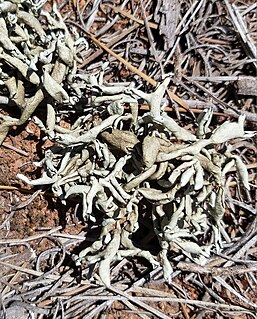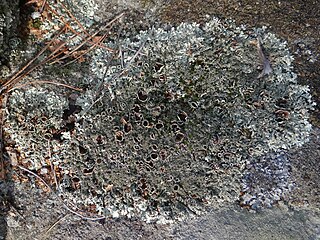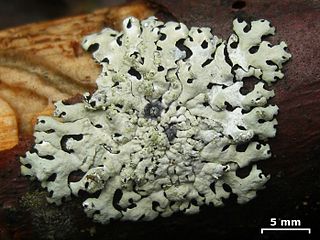
Arctoparmelia is a genus of ring lichens in the family Parmeliaceae. The genus was circumscribed by American lichenologist Mason Hale in 1986 with A. centrifuga as the type species. Hale included five species in his original conception of the genus; the Siberian species A. collatolica was added in 2019.

Bulbothrix is a genus of lichen-forming fungi in the family Parmeliaceae. This genus is synonymous with Bulbothricella V.Marcano, S.Mohali & A.Morales. Bulbothrix was circumscribed by lichenologist Mason E. Hale in 1974 with Bulbothrix semilunata as the type species.

Parmelina is a genus of lichen belonging to the family Parmeliaceae. The genus was circumscribed in 1974 by American lichenologist Mason Hale with Parmelina tiliacea assigned as the type species.

Relicina is a genus of foliose lichens belonging to the large family Parmeliaceae. It contains 59 species. Relicina was originally conceived as a series of the large genus Parmelia by lichenologists Mason Hale and Syo Kurokawa in 1964. A decade later, they promoted it to the status of genus.

Xanthoparmelia is a genus of foliose lichen in the family Parmeliaceae. Xanthoparmelia is synonymous with Almbornia, Neofuscelia, Chondropsis, Namakwa, Paraparmelia, and Xanthomaculina. This genus of lichen is commonly found in the United States, as well as Australia, New Zealand and Ecuador.

Xanthoparmelia convoluta is a vagrant lichen in the family Parmeliaceae found in Australia. It lacks rhizenes that hold it to a substrate, so it lives its life moving about in the wind.

Xanthoparmelia conspersa, commonly known as the peppered rock-shield, is a foliose lichen and the type species of genus Xanthoparmelia. It is widely distributed in temperate zones, and has been recorded from Japan, Europe, Africa, North America, and South America.

Xanthoparmelia mexicana, commonly known as the salted rock-shield, is a foliose lichen in the family Parmeliaceae. It grows in 4–10 cm diameter rosettes of gray-green to yellow-green lobes in arid climates all over the world.
Mason Ellsworth Hale, Jr. was one of the most prolific lichenologists of the 20th century. Many of his scholarly articles focused on the taxonomy of the family Parmeliaceae. Hale was one of the first lichen experts to incorporate secondary chemistry and technology such as computers and scanning electron microscopy into taxonomic work. Mason Hale published approximately two hundred articles and books on various aspects of lichen biology including taxonomy, anatomy, chemistry, and ecology. Hale also wrote several books aimed at education and increasing accessibility to lichens.

Xanthoparmelia scabrosa, jocularly known as sexy footpath lichen or sexy pavement lichen, is a foliose lichen in the family Parmeliaceae. It tolerates a very wide range of substrata, predominantly rock but also tree bark, roofing tiles, glass, and in wetter areas bitumen paths and roads.
Arctoparmelia separata, commonly known as the rippled ring lichen, is a species of foliose, ring lichen in the family Parmeliaceae with a roughly circumpolar distribution.
Vilmos Kőfaragó-Gyelnik was a Hungarian botanist and lichenologist.
Bulbothrix meizospora is a species of foliose lichen in the family Parmeliaceae. It is found in Africa, Asia, and South America, where it grows on tree bark.
Xanthoparmelia elixii is a lichen in the family Parmeliaceae, and found in South Australia.
Xanthoparmelia serusiauxii is a species of foliose lichen in the family Parmeliaceae. Found in Namibia, it was formally described as a new species in 1986 by American lichenologist Mason Hale. The type specimen was collected by Hale from the Laguneberg Mountains, southeast of Cape Cross. There, it is common on dolerite boulders and small, flat pebbles. The specific epithet honours Emmanuël Sérusiaux, who, according to Hale, "was the first lichenologist to collect this unusual lichen in Namibia".
Xanthoparmelia salazinica is a species of lichen in the family Parmeliaceae. Found in South Africa, it was described as a new species in 1989 by American lichenologist Mason Hale. He classified it in Karoowia, a genus that has since been placed in synonymy with Xanthoparmelia following molecular phylogenetic analysis published in 2010.

Parmelina quercina is a species of foliose lichen in the large family Parmeliaceae. It is found in continental Europe.

Hypotrachyna osseoalba, commonly known as the grainy loop lichen, is a species of foliose lichen in the family Parmeliaceae. It is widely distributed in subtropical and temperate areas of the world. Characteristic features of the lichen include the pustules in its cortex, the somewhat linear shape of the lobes comprising the thallus, and the branched rhizines.
Xanthoparmelia annexa is a foliose lichen species in the family Parmeliaceae. It was first formally described as a new species in 1964 by Japan lichenologist Syo Kurokawa. After being transferred to genus Paraparmelia in 1986, John Elix transferred it to the genus Xanthoparmelia in 2003 after the two genera were deemed to be synonymous.










